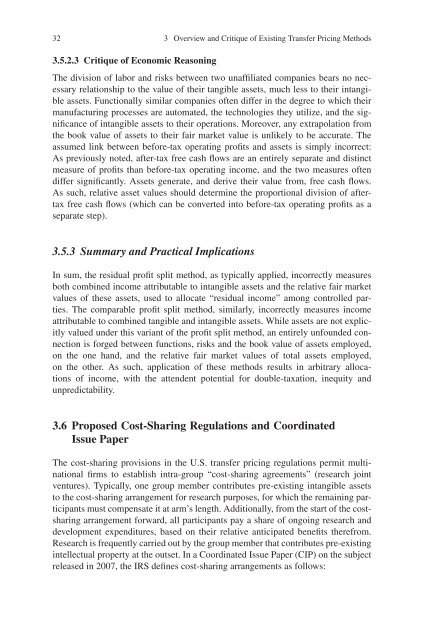Contents - AL-Tax
Contents - AL-Tax
Contents - AL-Tax
You also want an ePaper? Increase the reach of your titles
YUMPU automatically turns print PDFs into web optimized ePapers that Google loves.
32 3 Overview and Critique of Existing Transfer Pricing Methods3.5.2.3 Critique of Economic ReasoningThe division of labor and risks between two unaffiliated companies bears no necessaryrelationship to the value of their tangible assets, much less to their intangibleassets. Functionally similar companies often differ in the degree to which theirmanufacturing processes are automated, the technologies they utilize, and the significanceof intangible assets to their operations. Moreover, any extrapolation fromthe book value of assets to their fair market value is unlikely to be accurate. Theassumed link between before-tax operating profits and assets is simply incorrect:As previously noted, after-tax free cash flows are an entirely separate and distinctmeasure of profits than before-tax operating income, and the two measures oftendiffer significantly. Assets generate, and derive their value from, free cash flows.As such, relative asset values should determine the proportional division of aftertaxfree cash flows (which can be converted into before-tax operating profits as aseparate step).3.5.3 Summary and Practical ImplicationsIn sum, the residual profit split method, as typically applied, incorrectly measuresboth combined income attributable to intangible assets and the relative fair marketvalues of these assets, used to allocate “residual income” among controlled parties.The comparable profit split method, similarly, incorrectly measures incomeattributable to combined tangible and intangible assets. While assets are not explicitlyvalued under this variant of the profit split method, an entirely unfounded connectionis forged between functions, risks and the book value of assets employed,on the one hand, and the relative fair market values of total assets employed,on the other. As such, application of these methods results in arbitrary allocationsof income, with the attendent potential for double-taxation, inequity andunpredictability.3.6 Proposed Cost-Sharing Regulations and CoordinatedIssue PaperThe cost-sharing provisions in the U.S. transfer pricing regulations permit multinationalfirms to establish intra-group “cost-sharing agreements” (research jointventures). Typically, one group member contributes pre-existing intangible assetsto the cost-sharing arrangement for research purposes, for which the remaining participantsmust compensate it at arm’s length. Additionally, from the start of the costsharingarrangement forward, all participants pay a share of ongoing research anddevelopment expenditures, based on their relative anticipated benefits therefrom.Research is frequently carried out by the group member that contributes pre-existingintellectual property at the outset. In a Coordinated Issue Paper (CIP) on the subjectreleased in 2007, the IRS defines cost-sharing arrangements as follows:
















